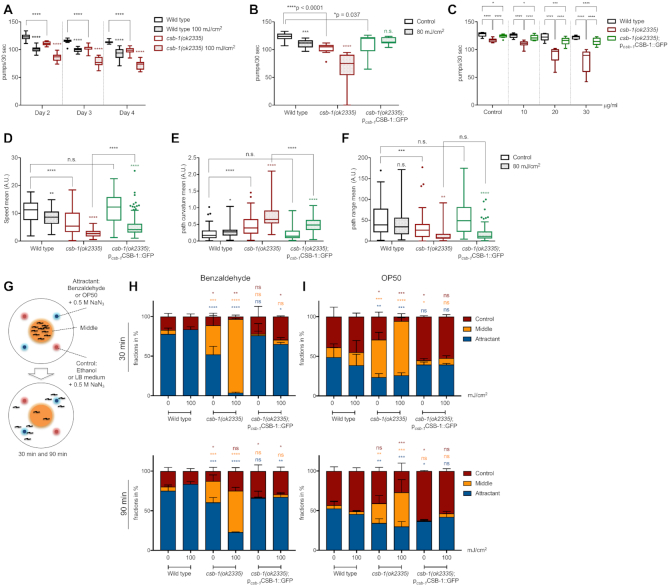Figure 1.
Behavioural changes imply neuronal defects in csb-1 mutants. (A) Pharyngeal pumping in wt and csb-1 mutants upon UVB irradiation. Nematodes were irradiated at Day 1 of adulthood, and assayed 24 h after irradiation (Day 2), 48 h later (Day 3) and 72 h later (Day 4) (n > 15 per group). (B) Pharyngeal pumping measured in the wt, the csb-1 mutant and the csb-1(ok2335);CSB-1::GFP rescue line upon UVB irradiation. Nematodes were irradiated at Day 1 of adulthood, and assayed 48 h after irradiation (n > 13 per group). (C) Pharyngeal pumping in the wt and csb-1(ok2335) (each carrying the pmec-4GFP neuronal reporter) and the csb-1(ok2335);CSB-1::GFP rescue line upon Illudin M treatment at different concentrations. Whiskers in (A) to (C) show the SD, statistics were computed with the non-parametric Mann-Whitney test with *P < 0.05, **P < 0.01, ***P < 0.001 and ****P < 0.0001 and Tukey outliers. (D, F) display locomotion features of wt, the csb-1 mutant and the csb-1(ok2335);pcsb-1CSB-1::GFP rescue line 24 h after UVB irradiation, with (D) mean speed, (E) mean path curvature, and (F) mean path range (in A.U.) (n ≥ 60). Significance is measured via the Mann-Whitney test with *P < 0.05, **P < 0.01, ***P < 0.001 and ****P < 0.0001, and Tukey outliers are shown as dots. Statistical significance in (A) to (F) without specific indication always refers to the colour-matched untreated control. (G) Experiment scheme of the chemotaxis assay (see Materials and Methods). (H) and (I) are chemotaxis assays in the wt, the csb-1 mutant and the csb-1(ok2335);pcsb-1CSB-1::GFP rescue line, quantified after 30 and 90 min, while (H) uses benzaldehyde, and (I) OP50 E. coli as attractant, respectively. Significance between zone-specific localization compared to the wt is measured by using the Welch's t-test with *P < 0.05, **P < 0.01, ***P < 0.001 and ****P < 0.0001.

